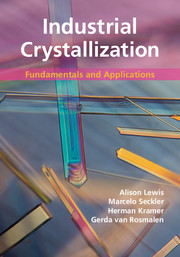Book contents
- Frontmatter
- Contents
- Nomenclature
- Industrial crystallization in practice: from process to product
- 1 Thermodynamics, crystallization methods and supersaturation
- 2 Characterization of a crystalline product
- 3 Basic process design for crystallization
- 4 Nucleation
- 5 Crystal growth
- 6 Agglomeration
- 7 The population balance equation
- 8 Batch crystallization
- 9 Measuring techniques
- 10 Industrial crystallizers
- 11 Precipitation and anti-solvent crystallization
- 12 Melt crystallization
- 13 Additives and impurities
- 14 Polymorphism
- Index
- References
8 - Batch crystallization
Published online by Cambridge University Press: 05 July 2015
- Frontmatter
- Contents
- Nomenclature
- Industrial crystallization in practice: from process to product
- 1 Thermodynamics, crystallization methods and supersaturation
- 2 Characterization of a crystalline product
- 3 Basic process design for crystallization
- 4 Nucleation
- 5 Crystal growth
- 6 Agglomeration
- 7 The population balance equation
- 8 Batch crystallization
- 9 Measuring techniques
- 10 Industrial crystallizers
- 11 Precipitation and anti-solvent crystallization
- 12 Melt crystallization
- 13 Additives and impurities
- 14 Polymorphism
- Index
- References
Summary
Why this chapter is important
There are a number of situations where batch operation is chosen instead of continuous operation (see Chapter 3). Batch processing is more economical for small production capacities of approximately 1 m3 of product per day or less, for processing of expensive materials (because product offspec losses are low) such as pharmaceuticals, as well as for processing batches of different materials in the same industrial unit. Batch crystallization is also chosen for processing of compounds that form encrustations on the crystallizer walls, because the encrustations can be washed off after each batch cycle. The major advantage of batch crystallization is the ability to produce uniformly sized particles.
Seeding is an important tool to control the product size, so the seeding technique will be treated in detail. Batch crystallization can be quantitatively described by means of population balances coupled with mass and energy balances as well as with kinetic expressions for the elementary processes. These mathematical models can be used to help understand batch processes, as well as to develop operational policies (temperature, evaporation and reactant addition trajectories throughout a batch process) aiming at improved product quality, low cost, and low raw material and energy usage.
Phenomenological description of batch crystallization processes
A batch cycle starts with a solution that is slightly undersaturated with respect to the solute to be crystallized. Crystallization is achieved by any of the methods described in Chapter 1, i.e., cooling, solvent evaporation, anti-solvent addition or chemical reaction (precipitation). Usually seeds of the crystallizing material are added early in the batch process in order to improve reproducibility and product quality. When the desired amount of solid has been formed, the slurry is transferred to a solid–liquid separation unit. The crystallizer is then washed, and fresh solution is added and brought to the desired temperature to start a new batch cycle.
The main elementary processes taking place during batch crystallization are described next. Cooling crystallization will be treated here, but the analysis can equally well be applied to evaporative crystallization.
- Type
- Chapter
- Information
- Industrial CrystallizationFundamentals and Applications, pp. 178 - 191Publisher: Cambridge University PressPrint publication year: 2015
References
- 1
- Cited by



